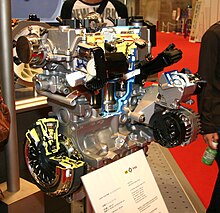Fully Integrated Robotized Engine
The FIRE engine (for "Fully Integrated Robotized Engine") is a series of engines from Fiat Powertrain Technologies . The Italian design office Rodolfo Bonetto was involved in the construction. The motor was assembled fully automatically on a robot line (“Robogate”), which made it cheaper to manufacture than its predecessor.
In the mid-1980s, the FIRE replaced the small Fiat OHV engine, which in its main features can be traced back to the engine of the Fiat 600 . The FIRE is a 4-cylinder in-line engine with five main bearings, a cast iron block and a timing belt-driven overhead camshaft in a light metal cylinder head with parallel hanging valves and bucket tappets .
The engine has been built in various versions since 1985, with displacements from 769 to 1368 cm³ with eight valves and in the so-called "Super-FIRE" version with 16 valves with 999 cm³ (Brazil) and 1242 cm³ (Brazil and Europe).
The engine was introduced in the Y10 (1985) of the Fiat subsidiary Lancia, followed by the Fiat Uno (1985) and Fiat Panda (1986).
The 1368 cc version, which was introduced in 2003, is available with both eight and 16 valves; In 2005 Fiat presented a version with variable intake manifold and exhaust gas recirculation . This engine is commonly called the “Starjet” engine. Also in 2005, a turbocharged 1368 cc version called the “T-Jet” engine was introduced, followed in 2009 by an engine with the Multiair electro-hydraulic valve control system .
The mixture of the FIRE initially came from a single Weber carburetor. Over the years, the engine was equipped with manifold injection and gradually developed into SPI (one-point injection), MPI (multi-point injection) and, most recently, SMPI (sequential multi-point injection). The FIRE engine is currently used in the Formula 750 in a slightly modified version.
List of FIRE engines
The FIRE was or will be built in the following displacement variants:
- 769 cm³ (0.8 l) with 65 mm bore and 58 mm stroke
- one overhead camshaft , 8 valves (1986–1992)
- 999 cm³ (1.0 l) with 70 mm bore and 64.9 mm stroke
- 8 valves (1986-1993)
- 8 valves manifold injection with one injection nozzle (single-point injection, SPI), (1987-2003)
- two overhead camshafts , 16 valves, intake manifold injection with one injection nozzle per cylinder (multi-point injection, MPI) (1998-2003, only Brazil)
- 8 valves, MPI, operation with any mixture of gasoline and alcohols ( flex-fuel ) (since 2005, only Brazil)
- 1108 cm³ (1.1 l) with 70 mm bore and 72 mm stroke
- 8 valves (70 mm × 72 mm) (1983–1993)
- 8 valves SPI (1993-2000)
- 8 valves MPI (since 2001)
- 1242 cm³ (1.2 l) with 70.8 mm bore and 78.9 mm stroke
- 8 valves MPI (1993–1999)
- 8 valves SMPI (1993–2009)
- 8 valves SMPI camshaft adjustment (Variable valve timing, VVT), (since 2007)
- 16 valves SMPI (1998–2009)
- 1368 cm³ (1.4 l) SMPI with 72 mm bore and 84 mm stroke
- 8 valves (since 2003)
- 8 valves, VVT (since 2005)
- 8 valves, flex-fuel (since 2005, only Brazil)
- 16 valves (since 2005)
- 16 valves, StarJet VVT , intake manifold (since 2005)
- 16 valves turbocharger T-Jet (since 2006)
- 16 valves MultiAir (variable valve lift), (since 2009)
- 16 valves MultiAir Turbo (since 2009)
use
- Autobianchi Y10 (1985) 999-1,108
- Fiat Uno (1986) 999-1,108
- Fiat Panda (1986) 750-999-1,108
- Fiat Tipo (1988) 1,108
- Fiat Punto (1993) 1,108-1,242
- Fiat Cinquecento (1994) 1,108
- Fiat Brava / Fiat Bravo (1995) 1,242
- Lancia Y (1996) 1,108-1,242
- Fiat Palio (1997) 1,242
- Fiat Seicento (1998) 1,108
- Fiat Punto (1999) 1,242-1,368
- Fiat Stilo (2001) 1,242-1,368
- Fiat Panda (2003) 1,108-1,242-1,368
- Fiat Idea (2003) 1,242-1,368
- Lancia Ypsilon (2003) 1,242-1,368
- Lancia Musa (2004) 1,368
- Fiat Grande Punto (2005) 1,242-1,368
- Fiat Bravo (2007) 1,368
- Fiat 500 (2007) 1,242-1,368
- Lancia Delta (2008) 1,368
- Fiat Fiorino (2008) 1,368
- Alfa Romeo MiTo (2008) 1,368
- Ford Ka (2008) 1,242
- Tata Indica Vista (2008) 1,242
- Tata Indigo Manza (2009) 1,368
- Alfa Romeo Giulietta (Type 940) 1,368
- Dodge Dart (2013) 1,368
- Fiat Viaggio 1,368
- Fiat 500L (2012) 1,368
- Fiat 500X (2014) 1,368
- Jeep Renegade (2014) 1,368
- Fiat Tipo / Aegea (2015) 1,368
- Fiat 124 Spider (2016) 1,368
- Fiat Tipo (2016) 1,368
production
As part of the 2009 company agreement, Chrysler began commercial production of the FIRE at its Dundee, Michigan facility. Chrysler's first FIRE variant, a 100 hp 1.4 liter FIRE Multiair, was first introduced in the 2010 Fiat 500.
Web links
Individual evidence
- ↑ OLIVARI - Rodolfo Bonetto . Olivari.it. Archived from the original on August 27, 2009. Retrieved October 12, 2009.
- ↑ By Noah Joseph RSS feed: Fiat increases stake in Chrysler to 25% . Autoblog.com. Retrieved September 29, 2012.
- ↑ Fiat increases ownership of Chrysler Group LLC from 20% to 25% (PDF; 19 kB). Accessed September 29, 2012.
- ↑ Chrysler Group LLC Introduces Fiats 1.4-liter, In-line 4-cylinder, Fully Integrated Robotized Engine with Multiair Technology to Powertrain Lineup
